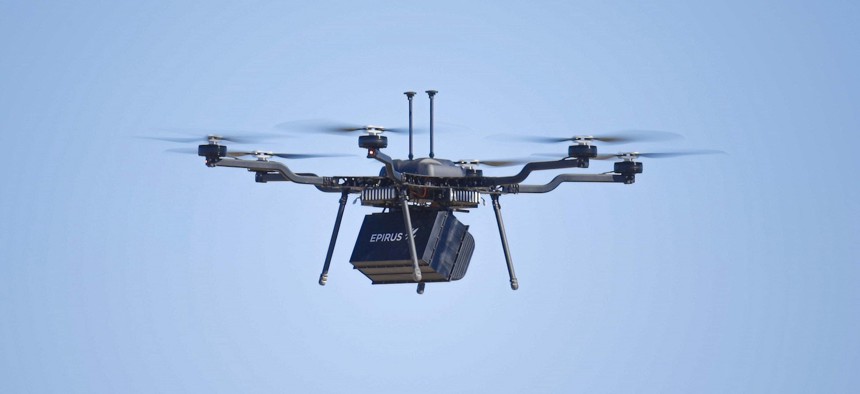PATRICK TUCKER

The military has been looking at a variety of ways to take down swarms of enemy drones, from hacking and jamming to lasers deployed on ships and trucks. Directed microwave energy has emerged as a promising option, but the bulkiness of conventional microwave weapons makes them a pain to lug around, and they aren’t as precise as necessary for an environment with friendly and enemy drones.
On Monday, California-based company Epirus announced their solution to this problem: a microwave-emitting pod that can sit on the bottom of heavy-lift drones and quickly down sudden drone swarms.
The Leonidas Pod, as they call it, builds off the company’s other, land-based microwave weapons, which use gallium nitride transistors to produce microwaves, rather than clunky magnetron vacuum tubes, of the sort that militaries have been using in radars for decades (and that likely create the waves in your microwave oven.) Gallium nitride microwave radar technology emerged as a research area around 2004, but didn’t make its way into counter drone technology until more recently.
That switch, from magnetron tubes to solid-state transistors, allows you to maintain a durable microwave beam with less power and in a much smaller container—small enough, in the case of the pod, to fit on the bottom of a heavy drone—Epirus CEO Leigh Madden told Defense One.
Contrast that with the Air Force Research Lab’s most cutting-edge weapon, the Tactical High Power Operational Responder— THOR—or the Army’s high-powered microwave weapon, both of which have performed well in tests but must be stored in 20-foot plus shipping containers.
And Madden says the new system has another benefit the current ones don’t: Because the handling is software based, the operator can better discriminate between friend and foe. “We can take sensor inputs from blue force trackers in the military, or IFF transponders on an aircraft, we can actually put a [protective sphere] around that friendly system and wherever that system goes, that [sphere] follows. That's driven by the software-defined ability of the system” he said.
Defense Department officials saw three demonstrations of the land-based version of the Epirus microwave last year. Madden says that they are working with the DARPA Warden program (developing algorithms for radio frequency applications) and the Army's Rapid Capabilities Office, among others, to bring the project to fruition.
No comments:
Post a Comment